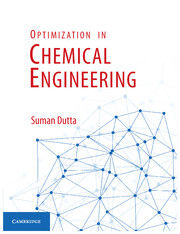Book contents
- Frontmatter
- Dedication
- Contents
- List of Figures
- List of Tables
- Preface
- 1 A Brief Discussion on Optimization
- 2 Formulation of Optimization Problems in Chemical and Biochemical Engineering
- 3 Single Variable Unconstrained Optimization Methods
- 4 Trust-Region Methods
- 5 Optimization of Unconstrained Multivariable Functions
- 6 Multivariable Optimization with Constraints
- 7 Optimization of Staged and Discrete Processes
- 8 Some Advanced Topics on Optimization
- 9 Nontraditional Optimization
- 10 Optimization of Various Chemical and Biochemical Processes
- 11 Statistical Optimization
- 12 Software Tools for Optimization Processes
- Multiple Choice Questions – 1
- Multiple Choice Questions – 2
- Multiple Choice Questions – 3
- Index
- References
10 - Optimization of Various Chemical and Biochemical Processes
Published online by Cambridge University Press: 05 February 2016
- Frontmatter
- Dedication
- Contents
- List of Figures
- List of Tables
- Preface
- 1 A Brief Discussion on Optimization
- 2 Formulation of Optimization Problems in Chemical and Biochemical Engineering
- 3 Single Variable Unconstrained Optimization Methods
- 4 Trust-Region Methods
- 5 Optimization of Unconstrained Multivariable Functions
- 6 Multivariable Optimization with Constraints
- 7 Optimization of Staged and Discrete Processes
- 8 Some Advanced Topics on Optimization
- 9 Nontraditional Optimization
- 10 Optimization of Various Chemical and Biochemical Processes
- 11 Statistical Optimization
- 12 Software Tools for Optimization Processes
- Multiple Choice Questions – 1
- Multiple Choice Questions – 2
- Multiple Choice Questions – 3
- Index
- References
Summary
Heat Exchanger Network Optimization
An important task during the design of chemical processes is to changing the process streams from their available temperatures to the required temperatures without additional cost. Heat recovery is an important approach for reducing the cost by using the heat available from streams to be cooled to the streams to be heated. The distinguish between hot streams and cold streams are made based on whether the stream is cooled or heated not on the basis of temperature. Developing an efficient energy system is very essential in process industry to reduce waste heat available. This waste heat from one process can be recovered and reused for another process. Heat Exchanger Network (HEN) is used to optimize this heat recovery consequently the investment cost and energy consumption in the process plant. Synthesis of HEN is one of the most commonly discussed problems in a process industry. This method has importance during determination of energy expenditure for a process and improving the recovery of energy in industry. The first systematic method was introduced in 1970s to heat recovery with the concept of pinch analysis. Hohmann (1971), and Linnhoff and Flower (1978) introduced the pinch analysis for synthesis of HEN. A single task is decomposed into three different subtasks (i.e., targets) like minimum utility cost, minimum number of units, and minimum investment cost network configurations. The major benefit of decomposing this HEN synthesis problem is that handling of these sub-problems are much simpler than the original single-task problem. The decomposed sub-problems are given below:
1. Minimum utility cost This subtask or target is related to the amount of maximum energy recovery that can be attained in a feasible HEN with a constant heat recovery approach temperature (HRAT), that allows to eliminate various non-energy efficient HEN structures. Hohmann in 1971, first introduced the minimum utility cost and then Linnhoff and Flower [Linnhoff and Flower, (1978)] discussed this technique. Cerda et al. (1983) discussed this as an LP transportation model and is improved as LP transshipment model by Papoulias and Grossmann [Papoulias and Grossmann (1983)].
2. Minimum number of units For a fixed utility cost, this target finds the match combination with the minimum number of units and distribution of their load. The overall cost of the HEN depends on the number of units.
- Type
- Chapter
- Information
- Optimization in Chemical Engineering , pp. 258 - 283Publisher: Cambridge University PressPrint publication year: 2016



